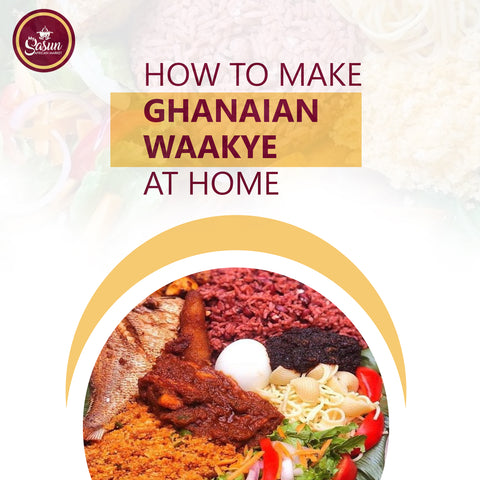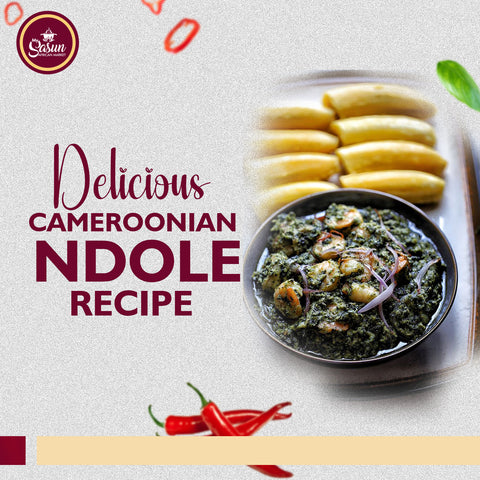Waakye is a beloved Ghanaian dish made from rice and beans, traditionally cooked with millet leaves to give it a unique color and flavor. This hearty meal is not only delicious but also packed with nutrients, making it a staple in many Ghanaian households. In this guide, we'll walk you through how to make authentic Ghanaian Waakye at home, step by step.
Also Read: 9 Myths and Facts about African Foods

Ingredients
To make Waakye, you'll need the following ingredients:
- 2 cups of rice (preferably jasmine or long grain)
- 1 cup of black-eyed peas or cowpeas
- 1 bunch of dried millet leaves (also known as sorghum leaves)
- 1 teaspoon of baking soda (optional, for enhancing the color)
- Salt to taste
- Water
Optional Ingredients for Serving:
- Stewed meat or fish
- Shito (Ghanaian hot pepper sauce)
- Fried plantains
- Gari (cassava granules)
- Hard-boiled eggs
- Avocado slices
- Sliced tomatoes and onions
Preparation Steps
Step 1: Preparing the Beans
- Soak the Beans: Rinse the black-eyed peas or cowpeas thoroughly. Soak them in water for about 2-3 hours to reduce cooking time.
- Cook the Beans: After soaking, drain the beans and place them in a large pot. Add enough water to cover the beans by about an inch. Bring to a boil, then reduce the heat and let them simmer until they start to soften (about 30 minutes).
Also Read: The Surprising Benefits of Eating More African Foods in the Diaspora
Step 2: Adding the Millet Leaves
- Prepare the Millet Leaves: Rinse the dried millet leaves to remove any dirt or debris.
- Add to the Pot: Add the millet leaves to the pot with the beans. If you're using baking soda, add it now. This helps enhance the color of the Waakye.
- Simmer Together: Let the beans and millet leaves simmer together for another 10-15 minutes. The water should turn a deep reddish-brown color.

Step 3: Cooking the Rice
- Rinse the Rice: While the beans and millet leaves are simmering, rinse the rice under cold water until the water runs clear. This removes excess starch and prevents the rice from becoming too sticky.
- Add the Rice to the Pot: Once the beans are tender and the water has changed color, remove the millet leaves. Add the rinsed rice to the pot with the beans.
- Cook Together: Add enough water to the pot to cook the rice. The ratio should be about 2 cups of water for every cup of rice, but this can vary depending on the type of rice used. Add salt to taste.
- Simmer Until Done: Bring the mixture to a boil, then reduce the heat to low. Cover the pot and let it simmer until the rice is cooked and all the water is absorbed (about 20-25 minutes). Stir occasionally to prevent sticking.
Also Read: Top 14 West African Foods for Gut Health and Digestive Wellness
Step 4: Serving Waakye
Waakye is typically served with a variety of sides and accompaniments. Here are some popular options:
- Stewed Meat or Fish: Prepare a flavorful stew with your choice of meat or fish to serve alongside the Waakye.
- Shito: This spicy Ghanaian pepper sauce adds a kick to the dish. You can make it at home or buy it pre-made.
- Fried Plantains: Slice ripe plantains and fry them until golden brown. The sweetness of the plantains complements the savory Waakye.
- Gari: Sprinkle gari (cassava granules) over the Waakye for added texture.
- Hard-Boiled Eggs: Add a hard-boiled egg to your plate for extra protein.
- Fresh Vegetables: Serve with sliced tomatoes, onions, and avocado for a refreshing touch.
Tips for Making Perfect Waakye
- Use Quality Ingredients: The quality of your rice and beans will greatly affect the final dish. Use fresh, high-quality ingredients for the best results.
- Don't Rush the Beans: Make sure the beans are tender before adding the rice. If the beans are undercooked, they will remain hard even after the rice is done.
- Adjust Water Levels: Different types of rice may require different amounts of water. Keep an eye on the pot and add more water if necessary to ensure the rice cooks properly.
- Season Well: Taste as you go and adjust the seasoning to your preference. Salt is essential to bring out the flavors in the dish.
Also Read: African versus Asian Foods: Which is Healthier, More Popular, and More Delicious?

Conclusion
Making Ghanaian Waakye at home is a rewarding experience that brings the flavors of West Africa to your kitchen. This nutritious and versatile dish can be enjoyed with a variety of accompaniments, making it perfect for any meal. Follow these steps and tips to create a delicious and authentic Waakye that will impress your family and friends.
FAQs
What are millet leaves, and where can I find them?
Millet leaves, also known as sorghum leaves, are used to give Waakye its distinctive color and flavor. You can find them in African grocery stores or online.
Can I use canned beans instead of dried beans?
Yes, you can use canned beans to save time. Just be sure to rinse them well and reduce the cooking time accordingly.
Is Waakye gluten-free?
Yes, Waakye is naturally gluten-free as it is made from rice and beans. Just be sure that any additional ingredients or accompaniments are also gluten-free.
Can I make Waakye without millet leaves?
Yes, you can still make a delicious Waakye without millet leaves, though it won't have the traditional color. The flavor will still be rich and satisfying.
How do I store leftovers?
Store any leftover Waakye in an airtight container in the refrigerator for up to 3 days. Reheat in the microwave or on the stovetop with a little added water to prevent it from drying out.
What can I use as a substitute for black-eyed peas?
You can substitute black-eyed peas with cowpeas or any other small, quick-cooking bean variety.
Also Read: African Foods for Healthy Skin and Hair







Comments (1)
My heart is so filled with joy. If you are suffering from Erectile dysfunction or any other disease you can contact Dr. Moses Buba on this buba.herbalmiraclemedicine@gmail.com or His website : https://www.facebook.com/profile.php?id=61559577240930 . For more information from me reach me via WhatsApp : +44 7375 301397